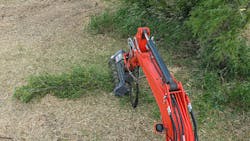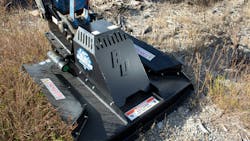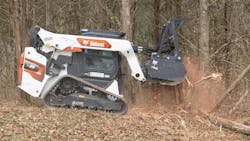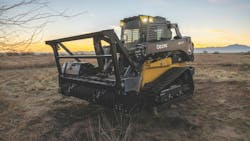Key Takeaways:
This article will help managers of land-clearing equipment:
- Understand how routine maintenance prevent downtime.
- Learn about maintenance of cutting tools.
- Learn how to prevent damage to hydraulic systems.
Proper maintenance of land clearing machinery and attachments ensures optimal performance and prolongs life. A scheduled preventive maintenance plan for tools such as mulchers and brush cutters and for carriers such as compact track loaders and excavators will minimize downtime and avoid costly repairs.
Inspect and clean land-clearing equipment
One of the most basic yet important maintenance tasks for any land clearing machinery is to ensure that it remains clean and free of debris. Clint Major, product development coordinator for Loftness, emphasizes the importance of keeping mulching heads clean to prevent debris buildup.
“If the rotor gets jammed with debris, operators should stop the attachment and roll it backward on the ground to clear the debris,” says Major.
More maintenance tips
Mulching heads with depth gauges help prevent excessive material intake that could cause stalls, but vines and other green materials can wrap around rotors.
Julie Portillo, product marketing manager at Bobcat, says that operators should also ensure skid steers or compact track loaders are clear of debris, especially in high-debris environments.
“Any machine in a high-debris application has potential for debris build-up on the machine and in various compartments,” she says.
Checking the motor housing and the area around the blade carrier prevents material pileups.
Monitor cutting teeth and blades
The cutting teeth or blades are key to the effective operation of land-clearing attachments. Keep cutting teeth and blades sharp.
“If knives are being used, they should be sharpened regularly and reversed as needed,” Loftness’ Major says.
Christopher Storr, product training manager at Blue Diamond Attachments, says in addition to sharpening blades, regularly check torque.
“Blade bolts should have proper torque—no more, no less—around 1,400 ft.-lb.,” Storr says.
Protect against rocks and foreign objects
Land clearing is often performed in rugged, unpredictable environmentsthat can cause significant wear on equipment.
“The most damage to mulching heads is caused by rocks or foreign objects,” says Emily Pagura, product marketing manager at John Deere.
To prevent such damage, operators should inspect the job site and remove debris before operation. For brush cutters, Storr recommends regularly cleaning the attachment to prevent large debris from becoming caught by the cutter’s blade carrier.
Prevent hydraulic system contamination
Hydraulic systems are a core component of land clearing equipment, and contamination can quickly lead to significant damage. This can be mitigated by making sure the host machine’s maintenance is up to date.
Portillo echoes the importance of keeping hydraulic systems in good shape.
“Bobcat offers a pre-cleaner on certain models that helps prevent larger debris from entering the engine intake, extending filter life,” she says.
In addition to checking hydraulic hoses and fittings, Major at Loftness advises ensuring that the hydraulic system of mulching heads is regularly inspected.
“Operators should add grease every 250 hours for grease-filled direct drives and change oil every 1,000 hours for oil-filled direct drives,” he says.
Perform regular checks on the carrier
Maintenance doesn’t end with attachments; the carrier—whether a skid steer, compact track loader, or tractor—also requires regular attention.
“Daily inspections and ensuring proper maintenance of the hydraulic system will help keep operators productive on their land clearing job site,” Bobcat’s Portillo says.
Safety in maintenance
Safety should be a priority when performing maintenance on land-clearing equipment. Whether inspecting cutting teeth, hydraulic hoses, or the carrier’s engine, operators should always ensure that the equipment is powered down before starting any work. Shut down and lock out power before attempting to perform any maintenance on an attachment.
About the Author
Harlee Hewitt
Harlee is a former associate editor for Construction Equipment.



